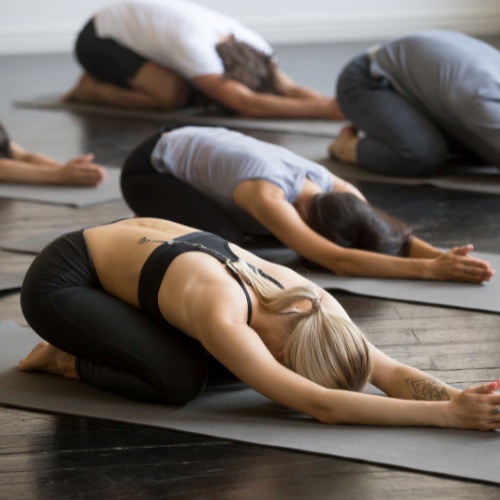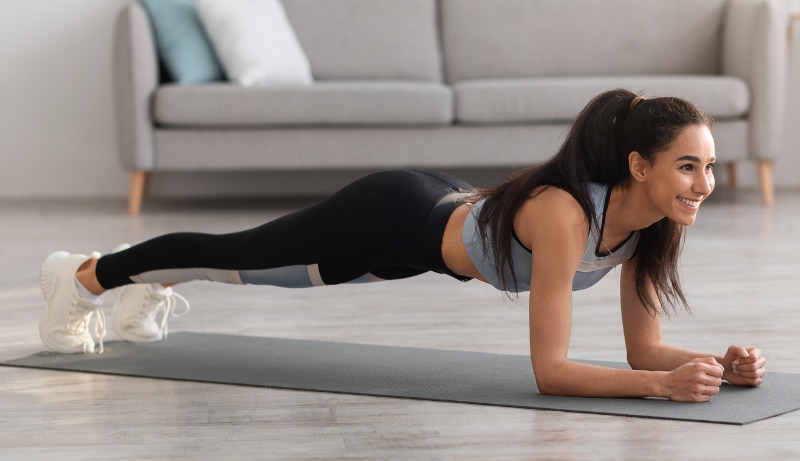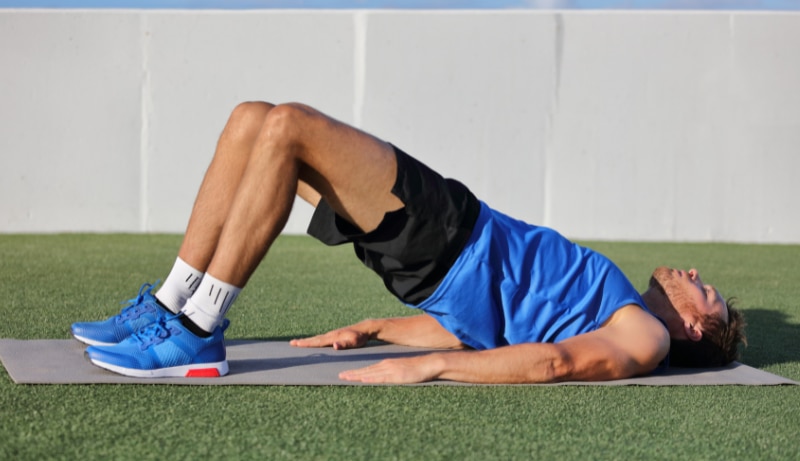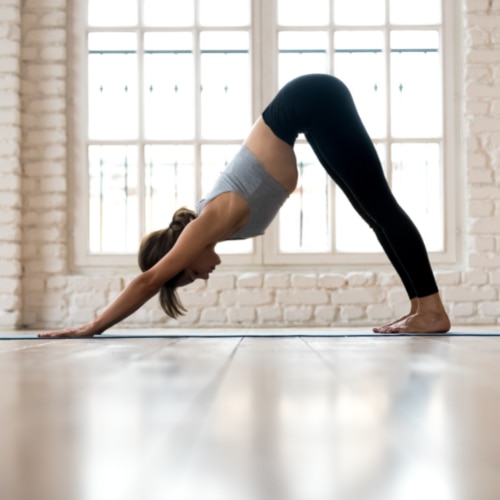5 daily posture exercises
How often do you spend working away at your desk or sat down generally? Adults reportedly spend more than seven hours a day sitting or lying down, and the older we get, the higher this figure gets (around 10 hours a day or more).1 Why have we mentioned this? Well, sitting down for hours on end can potentially take its toll on our posture and possibly lead to issues with your back muscles.2
What is good posture?
If your posture’s good, your body is correctly aligned and being supported by your muscle and muscle tension.
Having a good posture can:2
- Reduce strain on the body during movement and exercise
- Maintain balance while moving and exercising
- Decrease the risk of muscle strain and conditions related to overuse
- Reduce wear and tear on the joints, muscles, and ligaments
- Improve spine health
Overall, a good posture enables us to sit down or stand up with minimal effort and without putting strain on our body.3
What is bad posture?
There are two forms of poor posture. The type that can be corrected, and the type where it’s fixed and restricts people’s ability to move.3
The correctable posture is usually caused by sitting or standing in a slouched position; your postural muscles can get used to being in that position. Repeated coughing can also result in people poor postural positions that can potentially cause their back to become stiff or weak over time.
Fixed bad postures tend to develop in people who have breathing difficulties. This is due to the fact their muscles are having to work harder, so aren’t fully dedicated to helping control posture.
The day-to-day effect of, injury, illness, genetics, and gravity on our bodies can all also play a part in impacting people’s postures.4
Can you fix bad posture?
It’s certainly possible to do some work to help improve your posture. Whether or not you’re able to ‘fix’ a bad posture very much depends on the severity and what’s causing it.
There are lots of different exercises you can follow and tips you can incorporate into your everyday life to help alleviate muscle tension that’s being caused by poor sitting and standing habits.
A lot of this guidance involves pressing the ‘reset’ button on some of old ways of sitting, standing and walking. These may take a little getting used to, and a lot of thinking about at first. However, the more you practice them, the more they should gradually become more of a natural thing.5
How do I correct my posture?
By working on it and, as you do, developing strength, flexibility and balance throughout your body.
The more you work on your posture and become aware of your overall body alignment (or aches and pains that you may not have really given much thought about until now), the more you’ll recognise what’s great and not so great about your posture.
Working on your posture is something that can easily be incorporated into your everyday routine. You just need to get into the habit of doing certain posture-correction exercises or do some all-round good.
5 exercises to improve posture
1. Child’s pose
What it’s good for:
Stretching and lengthening your spine, glutes and hamstrings and releasing tension in your lower back muscles and neck.6
- Sit on your shinbones with your knees together, your big toes touching, and your heels splayed out to the side.
- Fold forward at your hips and walk your hands out in front of you.
- Sink your hips back down toward your feet. If your thighs won’t go all the way down, place a pillow or folded blanket under them for support.
- Gently place your forehead on the floor or turn your head to one side.
- Keep your arms extended or rest them along your body.
- Breathe deeply into the back of your rib cage and waist.
- Relax in this pose for up to 5 minutes while continuing to breathe deeply.7

2. Forward fold
What it’s good for:
Releases tension in your spine, hamstrings and glutes and stretching your hips and legs.8
- Stand with your big toes touching and your heels slightly apart.
- Bring your hands to your hips and fold forward at your hips.
- Release your hands toward the floor or place them on a block. Don’t worry if your hands don’t touch the ground — just go as far as you can.
- Bend your knees slightly, soften your hips joints, and allow your spine to lengthen.
- Tuck your chin into your chest and allow your head to fall heavy to the floor.
- Remain in this pose for up to 1 minute.

3. Plank
What it’s good for:
Strengthening your back shoulder muscles, glutes, hamstrings, and lower back and core muscles.9
- Lie on your front propped up on your forearms and toes.
- Keep your legs straight and hips raised to create a straight and rigid line from head to toe.
- Your shoulders should be directly above your elbows.
- Focus on keeping your abs contracted during the exercise.
- Hold this position for 5 to 10 seconds and repeat for around 8 to 10 times.

4. Bridges
What they’re good for:
Releasing tension and pressure in and around your buttocks and lower back.10
- Lie on your back with your knees bent and heels close to your bottom. Your feet should be shoulder-width apart and flat on the floor.
- Raise your hips to create a straight line from your knees to your shoulders. As you come up, tighten your abdominals and buttocks. Lower yourself gently to the starting position.
- Repeat between 8 and 10 times.

5. Downward facing dog
What it’s good for:
Balancing out your body, strengthening and aligning your back muscles.11
- Lying with your stomach on the floor, press into your hands as you tuck your toes under your feet and lift your heels.
- Lift your knees and hips to bring your sitting bones up toward the ceiling.
- Bend your knees slightly and lengthen your spine.
- Keep your ears in line with your upper arms or tuck your chin all the way into your chest.
- Press firmly into your hands and keep your heels slightly lifted.
- Remain in this pose for up to 1 minute.

Best practice advice for sitting at your desk correctly
Whether you work from home or in an office, maintaining the right posture while you’re working is key. So if you’re looking to optimise your desk posture, follow these steps below:12
- Support your back – by having a chair where you can adjust the height, back position, and tilt. Make sure your knees are slightly lower than your hips.
- Adjust your chair – you should be able to use your keyboard with your wrists and forearms straight and level with the floor.
- Rest your feet on the floor – make sure they are flat on the floor. If they don’t reach, use a footrest. Do not cross your legs as this can lead to posture-related issues.
- Position your screen – so that it’s directly in front of you, about an arm’s length away and the top of it is at eye level.
- Position your keyboard – in front of you, leaving a gap of around 4 to 6 inches at the front of the desk, so that you can rest your wrists if you need to.
- Put your mouse – as close as possible to you and use a mouse mat with a wrist pad to keep your wrist straight.
Other things that can help you maintain normal bones and muscle function
- Eating a balanced diet that contains plenty of calcium, which is essential for the maintenance of normal bones. Good food sources include: dairy, green leafy vegetables, soya beans and tofu.13
- Making sure you have enough vitamin D in your system, which helps the body to absorb calcium.14The main source of vitamin D is from the sun, so in the winter months, you may want to take a vitamin D supplement.
- Taking care of your bones and making sure they stay healthy.
- Exercising regularly to help keep your body healthy. It can help strengthen the muscles that support your body and help maintain a healthy weight. One of the best forms of exercise that you can do for posture is Pilates, as it helps to bring awareness to your alignment and strengthen your postural muscles.15,16 Your postural muscles are the deep muscles in your back, pelvis and abdomen.17
The final say
From releasing tension in the deep muscles of the back to stretching your postural muscles, these exercises should help you to improve your overall posture. Inspired by these moves and stretches? Discover five different yoga sessions and find the best one for you, right here on the Health Hub.